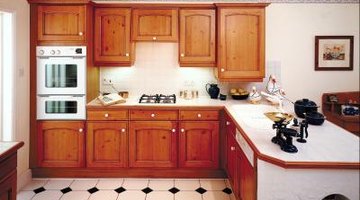Cabinet Varnish Hazards
Varnish, also called lacquer, is applied to the surface of wood and helps bring out its natural beauty. And while varnish can enhance and protect wood products, it also has some dangers. When it is still wet, varnish is combustible. Varnish often contains formaldehyde, which poses a serious health risk and can cause cancer, according to the U.S. Environmental Protection Agency. The March of Dimes states that the solvents used in varnish may also cause birth defects.
Poisonous

Highly toxic, cabinet varnish poses a poisoning risk. Varnishes contain hydrocarbons, a mix of hydrogen and carbon, which causes poisoning if ingested. Anyone who accidentally swallows varnish should seek medical treatment immediately. Ingestion causes a gastrointestinal disturbance and nervous system disorders. The sufferer may vomit, have abdominal pain, burning of the esophagus, bloody stools, low blood pressure, heart failure, sleepiness, coma, brain damage and possible death, states MedlinePlus.
Inhalation
Always wear a respirator and eye protection when applying varnish to a cabinet or sanding varnish covered cabinets. Sanding varnished cabinets creates dust that can also cause health and respiratory problems if inhaled. Inhaling the fumes or dust of varnish can result in respiratory distress and pulmonary edema. It can also cause nose, eye and mouth pain. The throat may swell, and breathing may become difficult.
Additional Dangers
Varnishes often contain benzene. Exposure to benzene can result in a buildup of the chemical in the bone marrow, fat and liver, according to the North Carlina State Cooperative Extension Service's website. The Centers for Disease Control and Prevention states that exposure to solutions that contain benzene can cause cancers such as leukemia to occur. Benzene in varnish also helps make the solution highly combustible. Always wear protective clothing and gloves when applying varnish to a cabinet because it can cause skin irritation or burning.
Environment
Some varnishes used on cabinets contain petroleum-derived and synthetic solvents. They pose a significant risk to the environment by emitting high levels of VOCs (volatile organic compounds). The World Health Organization states that VOCs cause smog to occur; they also have adverse effects on animals, plants, the water and soil. Some environmentally friendly varnishes offer low-VOCs of 350 grams per liter. The manufacture of varnish that contains VOCs also poses a threat to the environment by emitting the chemicals into the atmosphere.
References
- Cabinet Q and A: Finishes for Wood Kitchen Cabinets
- Kitchen-Cabinets-And-Hardware.com: Lacquer Cabinets
- U.S. Environmental Protection Agency: An Introduction to Indoor Air Quality
- MedlinePlus: Lacquer Poisoning
- U.S. Green Building Council's Green Home Guide; Selecting Healthy and Environmentally Sound Clear Wood Finishes; Alex Pennock, et al.; September 2009
Resources
Writer Bio
Based in Oregon, Kimberly Sharpe has been a writer since 2006. She writes for numerous online publications. Her writing has a strong focus on home improvement, gardening, parenting, pets and travel. She has traveled extensively to such places as India and Sri Lanka to widen and enhance her writing and knowledge base.
Photo Credits
- Jupiterimages/Photos.com/Getty Images
More Articles



